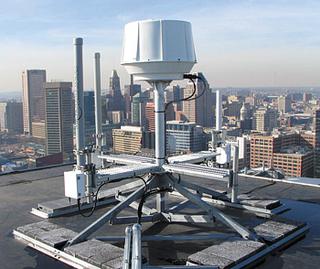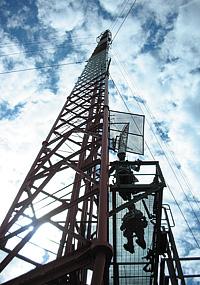Staying on Schedule
LOS ANGELES Equipment manufacturers are generally upbeat about fulfilling their roles in completing the BAS transition sometime next year. But they hedge their bets on the exact timing of the end date, the specific task in question, and intangibles such as weather, broadcasters, other suppliers, contracted services, and other inevitable surprises—like the February 2009 analog shutoff—that may affect the outcome.
Although the FCC deadline is March 5, 2009, Sprint-Nextel anticipates that the transition will finish up in August. According to FCC spokesman Matt Nodine, at presstime there were no filings to extend the March deadline.

MRC installed this central receive site in Baltimore with an UltraScan antenna and four omnidirectional antennas. This purpose of this system is for long range auto tracking applications, including state of the art diversity reception. Of the half dozen manufacturers queried by TV Technology, only one spokesman indicated that March 5 would be a viable end date, and it would only be so for equipment delivery; more time would probably be needed for installation and integration. Most thought the project could be completed in August and all seemed reasonably assured that the task was doable by the end of 2009.
COMPLEXITIES
Despite the above deadline consensus, at least one rep believed the FCC's insistence on benchmarks was necessary.
"There were virtually no purchase orders until almost the beginning of this year," said Sunil Naik, director of engineering for Moseley Associates in Santa Barbara, Calif. "At the end of last year the FCC forced them, and everything changed."
Purchase orders are important not only because they seal the deal but because they are required for the broadcaster (and area) to be included on Sprint-Nextel's transition ("market cutover") schedule. The multiphased business cycle was instituted as follows:
- Broadcaster request for eligibility;
- Frequency Relocation Agreement (FRA) with Sprint-Nextel;
- Manufacturer quotes;
- Sprint-Nextel approval;
- Purchase order;
- Delivery, installation and integration.
Another manufacturer estimated the number of FRA agreements still missing official purchase orders at about 12 percent, still problematic, though much improved. (A Sprint-Nextel spokesman put the number at approximately 3 percent.)
Naik said facing the flood of purchase orders resulting from the loosened chokehold caused an inevitable "hiccup" in "going from zero to 100 miles per hour."
This scenario was further complicated by omissions and misinformation in the orders themselves, which impacted immediate shipping schedules as well as inventory.
The dilemma was (and continues to be) worse for special order requirements, such as out-of-band 13 GHz radios or specialized transmitter-receivers.
Misinformation came in at least two varieties: equipment ordered and equipment already owned by the broadcaster.

Western Technical Services installed this BAS ENG replacement antenna system last month on Mount Wilson, the premier TV broadcast facility in southern California. This installation is for KCBS-TV's principle broadcast tower site. "Over the last year we worked very hard, along with other manufacturers and Sprint-Nextel, to really focus on communicating with customers to know what their needs are and the individual intricacies of a certain market," said Keith Blaisdell, director of engineering, RF Central in Carlisle, Pa. "There are no cookie cutter solutions."
The interdependent nature of the project alluded to by Blaisdell also made working with a myriad of vendors—often competitors—essential to provide working solutions.
"You're looking for everyone in the market to have their equipment," Blaisdell said. The availability of service providers was also tricky, he said, noting his company's dependence on an independent tower crew. "We don't climb towers; we do all the infrastructure work at the base of the tower or truck," he said.
According to Dan McIntyre, vice president for Microwave Radio Communications in North Billerica, Mass., coordinating the schedules of numerous companies doing separate but interdependent installations of various vendors' products is further complicated by a relatively small workforce capable of installing and integrating the equipment. Furthermore, he said, if any one piece of equipment does not work as stated, "crews have to come back a second time."
Still, most manufacturers conceded that the business cycle has improved, thanks to their own initiatives and improvements enacted by Sprint-Nextel.
IMPROVEMENTS OVER TIME
"Initially none of us had the capacity to produce the equipment volume that Sprint-Nextel needed—we all had to build up our workforces," said McIntyre. "Today every equipment vendor and every installation company is better equipped than they were three years ago—there's no question about it."
He noted that MRC itself "tripled the number of people who do integration/installation type of work," buying up the assets of another company and opening new offices in the process. In early 2007, the firm also implemented a pre-delivery systems integration test for all receive site radios, antennas, control systems and cabling that the customer would receive as a system.
In addition, McIntyre credited Sprint-Nextel for streamlining its request-quote-approval-ordering procedures and instituting Market Cutover Tracking conference calls with equipment vendors and installers to ensure timelier and smoother market transitions.
Despite the improvements, manufacturers were reluctant to estimate delivery time due to the complexity of the installations, radio mix and other variables. Manufacturers with outstanding orders believed they would be caught up by October or November.
All noted that most of the big projects—top 30 DMAs like New York, Miami, and San Francisco—had yet to be started. But all were reasonably confident about tackling them.
Get the TV Tech Newsletter
The professional video industry's #1 source for news, trends and product and tech information. Sign up below.
